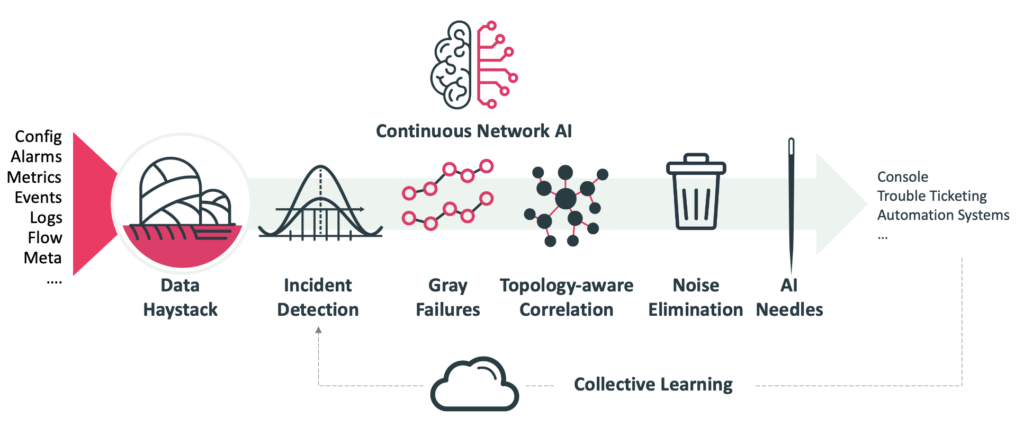A child takes two examples of a plane to get it. A machine, perhaps 10,000. There have also been public failures in applying AI from a chatbot called Tay to potentially deadly recommendations for treating cancer. What exactly is AI good for? Quite a bit it turns out, and specifically for network operations, where AI is now shining.

When AI Does Not Shine
Whether the things machines do is artificial “human” intelligence, is a debate on its own. Machines do amazing things humans cannot do. However, it is when they try to do things humans do well, they can sometimes have unpredictable and tragic results – especially when there is significant uncertainty.
Consider healthcare. What modern medicine knows about the human body is remarkable. At the same time, what is not known remains extensive. There is enormous uncertainty in many aspects of diagnosis and treatment. As a father of children with the statistical probability of a genetic disease that arises from any one of thousands of different gene variations / combinations, I have spent many decades contemplating the non-binary nature of some aspects of medicine.
When IBM’s Watson, which had been custom-built to win a quiz show, took on cancer treatment recommendations, rather than the narrower credibility demonstrations recommended by medical experts working for IBM, the results were sadly predictable, by humans at least, if not AI. When Microsoft’s Tay tripped over social norms, without knowing that some rules in society are inviolate, and others are relative to who the speaker is* results were disastrous as well. (* Machines do not yet know who they are).
Other AI fails have been in areas such as facial recognition showing racial bias, investing, AI-driven devices being out of control and a hazard to those around them, and more.
All the above give reason for those working in AI to stay humble about what AI can and cannot do. Start with narrow cases, and look to where AI does well. Some of this is part of the learning process and some of it is the nature of the problem.
Automating Rules
The implementation and execution of rules may once have been considered AI, today though, not so much. However, they are extremely important. Rules represent learned knowledge. The manifestation of that knowledge is software code executing what a skilled practitioner has learned through experience. Care must be taken to make rules easy to define and apply in real-time, and there may be other challenges as well. However, rules can provide high-fidelity signals.
AI Shines in Understanding Network Patterns
Augtera has developed 9+ purpose-built algorithms, because not all networks are the same, and not all patterns within a single network are the same either. Some of the good results Augtera is getting today, has come from past failures.
For example, when Augtera first started detecting the change in rate of Syslog messages, it led to very noisy anomaly detection. Change is not necessarily the same as operationally relevant. Systems that simply alarm on something being “abnormal” can generate noise. Following that failure, Augtera developed an algorithm that understands more than a simple variation, it understands message “bursts”. Noise has now been reduced considerably from previous approaches.
Areas that have worked well include combining specific patterns, an extensive multi-layer, topology-aware model of the network, and the network experience of both Augtera and its customers. Optical degradation preceding future failure, link anomalies, BGP anomalies, traffic anomalies, semantically new syslog messages, and fabric congestion impact on application performance are just some of the areas where Augtera’s Network AI is producing high-fidelity results.
AI Shines in Auto-Mitigation and Remediation
The future will no doubt see significant innovation in auto-mitigation and remediation. Today, network operations teams are taking baby steps, developing trust in automation. However, even those baby steps are extremely valuable. There is a set of anomalies which have the same mundane resolution. Experienced network operations people know what the problems look like, and what the time-proven response is. Responses to these anomalies can be automated, relieving operations teams from having to do the same thing, manually. AI, and specifically Network AIOps will shine in this area of networking. This is far from the complex decision making that many might assume is the realm of AI. However, compelling value is realized, and it is a start down the road to the future.
Conclusion
The history of AI humbles us all, or at least it should. At Augtera, we are not sending hundreds of millions of dollars to build the ultimate brain that makes all decisions in a network. We are instead taking on narrow problems where machine learning, natural language processing, correlation, and other AI/ML techniques can make a compelling contribution and where AI can shine in networking: identifying the root source of an incident, detecting degrading performance in optics, reducing noise by using algorithmic detection of anomalies rather than thresholds, and where appropriate, integrating customer / industry experience with classifiers and policy. The road ahead is long with many unpredictable and remarkable innovations to come. Even if AI in networking has not yet produced that highly, and today overly ambitious goal of a single brain making all decisions in the network, it is still producing game changing results: cutting incident queues by a factor of 10, increasing the time between incidents by a factor of 4, reducing mean-time-to-mitigation by over 50%, and more. Staying humble and staying narrow is producing compelling results, today.

